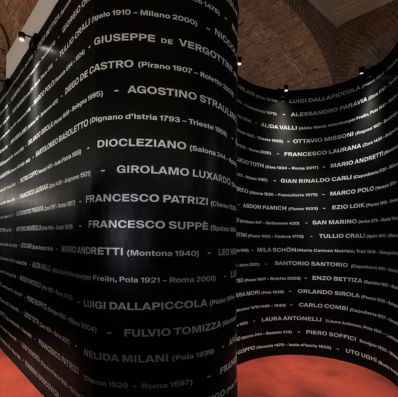
Saturday, October 25, 2025
Grottone Hall - Vittoriano
Eighty years after the end of the Second World War, the story of the Fiuman, Dalmatian, and Istrian exiles finds a home within Vittoriano, a museum that serves as the beating heart and living memory of our Nation, now directed by Edith Gabrielli, General Director and member of the exhibition’s scientific committee.
Through documents, photographs, objects, and first-hand testimonies selected and organized by a multidisciplinary scientific committee, the exhibition—hosted in the Grottone Halls and curated by the architect Massimiliano Tita—restores truth and dignity to a chapter of Italian history that for too long has been silenced, minimized, or even distorted.
The project was initiated by the Federation of Associations of Istrian, Fiuman and Dalmatian Exiles (in collaboration with the Adriatic Coordination, the Multimedia Documentation Centre, and the National Association Venezia Giulia e Dalmazia), with the support of the Ministry of Foreign Affairs and the Ministry of Culture. Twenty years after the establishment of the Giorno del Ricordo (Law no. 92 of March 30, 2004) and considering the highly symbolic and patriotic significance of the National Monument to Victor Emmanuel II in Rome, this initiative fulfills the vision of the late President of the Republic Carlo Azeglio Ciampi: to conclude the Risorgimento narrative within the Vittoriano by creating a space dedicated to memory, guiding visitors through the Italian identity of the Eastern Adriatic territories.
Conceived as a living, open, and welcoming space, The Exhibition of Fiuman, Dalmatian and Istrian Exiles (MEDIF) is primarily aimed at young people and students, while inviting all those who wish to engage with history without prejudice, in order to build a shared historical awareness within a European context. The history of the Adriatic border is no longer merely a wound, but becomes a frontier of encounter and dialogue.
The exhibition design—narrative, dynamic, and entirely reversible—was conceived to engage the visitor through variations of geometry and perspective. The experience is guided by two main elements: a dark, textured shell evoking the weight of history, and a continuous, suspended ribbon of Corten steel, symbolizing a journey through time.
The rich multimedia itinerary includes interactive installations with exclusive content documenting major events, personal testimonies, and the names and faces of the protagonists. Particularly moving is a symbolic installation dedicated to the victims of the foibe and to Norma Cossetto: a Thonet chair with a monocle aimed at a red rose among the rocks. The exhibition concludes with a multifunctional hall designed for institutional events, where the Italian flag is displayed alongside the banners of Istria, Fiume, and Zara.
Free admission